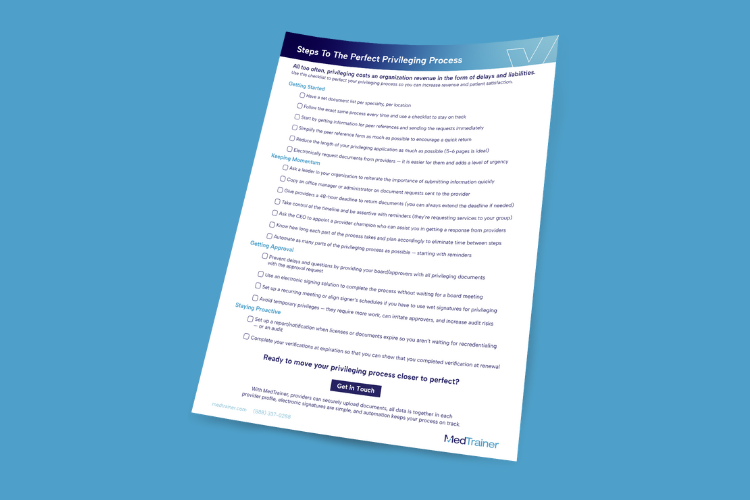The provider privileging process can be a significant pain point for healthcare executives due to its time-consuming and resource-intensive nature. Understanding what is privileging in healthcare— the process of verifying and authorizing a healthcare provider to perform specific procedures—is crucial. The extensive administrative workload required to gather, verify, and review all necessary documentation can strain staff and delay bringing new providers on board, directly impacting patient care and revenue. Additionally, navigating the complex and frequently changing regulations and standards increases the risk of non-compliance, potentially leading to legal and liability issues.
Executives must also contend with coordination challenges across departments and external entities, which can lead to communication breakdowns and further delays. Outdated or inefficient credentialing systems exacerbate these issues, causing frustration and errors. The high stakes in privileging decisions and balancing thorough vetting with urgent staffing needs add to the stress, making it clear that a streamlined and effective privileging process is crucial for maintaining operational efficiency, compliance, and financial health.
Implementing advanced credentialing software can significantly alleviate these pains by automating and streamlining the privileging process, ensuring accuracy and compliance while reducing administrative burdens. This article will address what is privileging in healthcare, the impacts proper privileging has on organizations, and how credentialing software is critical for managing the process.
What Is Privileging in Healthcare?
Privileging in healthcare authorizes a healthcare practitioner’s specific scope and content of patient care services within a healthcare facility. Here are the key aspects of privileging:
- Purpose: Privileging confirms that healthcare providers act within the scope of their practice and provide competent patient care in line with their role at the facility.
- Process: The privileging process typically involves the following steps:
- Determining needed privileges based on the provider’s specialty and scope of practice
- Provider application for specific privileges
- Verification of credentials, education, training, and licensure
- Peer review to assess clinical competence and expertise
- Approval of privileges by the facility
- Ongoing monitoring and re-evaluation of the provider’s performance
- Requirements: To be granted privileges, providers must prove they can perform specific skills they intend to practice. This may include demonstrating:
- Education and training relevant to the requested privileges
- Current medical license and certifications
- Clinical experience and competence
- Appropriate malpractice insurance coverage
- Types of Privileges: Common categories of privileges include:
- Admitting privileges: Allowing a doctor to admit patients to the hospital
- Courtesy privileges: Permitting occasional treatment or admission at the hospital
- Surgical privileges: Authorizing the physician to perform outpatient or operating room surgeries
- Regulatory Compliance: Privileging is required by regulatory bodies such as the Centers for Medicare and Medicaid Services (CMS) to ensure patient safety and quality of care.
- Ongoing Process: Privileging is not a one-time event. Healthcare facilities must continuously monitor and re-evaluate providers’ performance to show they maintain the necessary skills and competence.
- Distinction from Credentialing: There is a distinct difference between credentialing and privileging. While credentialing verifies a provider’s qualifications and background, privileging specifically authorizes the scope of patient care services a provider can perform at a particular facility.
Privileging plays a crucial role in maintaining high standards of patient care by ensuring that healthcare providers are qualified and competent to perform the specific services they offer within a healthcare facility.
WEBINAR: Hear how Kasey Krabler of Rocky Mountain Surgical Center completes privileging in 30 days.
Impacts of Privileging on Healthcare Operations
As the healthcare landscape continues to evolve, with increasing emphasis on the ongoing monitoring and reassessment of healthcare providers to maintain high standards of care, the importance of robust privileging practices has never been more pronounced. Understanding why privileging matters is essential for organizations that foster a culture of excellence and safety in healthcare delivery. Here are several critical reasons for proper privileging management at the executive level:
Reducing Costly Delays
Every day, a provider’s lack of privileges to deliver patient care can cost a healthcare organization thousands of dollars in revenue. Inaccurate or incomplete application information, lagging peer references, and administrative backlogs may result in delays. Providers can request temporary privileges to get reimbursements coming in, but this costs the organization money by duplicating the process and forcing leaders to approve privileges more than once.
Enhancing Clinical Effectiveness and Quality of Care
Credentialing and privileging are essential actions that organizations take to enhance clinical effectiveness and deliver high-quality patient care. These processes help verify that healthcare providers are qualified, competent, and capable of delivering safe and effective care.
Compliance with Regulatory Requirements
Healthcare organizations are legally responsible for verifying that all providers are properly credentialed and privileged. They must be able to produce all documentation and approvals for the privileges to simplify information requests during audits and surveys. Proper privileging documentation is also critical to meet the standards of regulatory bodies such as the Centers for Medicare and Medicaid Services (CMS) and the National Committee for Quality Assurance (NCQA).
Mitigating Legal and Financial Risks
Proper privileging helps protect healthcare facilities from negligent credentialing lawsuits, which can result in significant financial and administrative consequences. Such lawsuits can threaten a hospital’s ability to participate in federally funded programs like Medicare and Medicaid.
Supporting Value-Based Care Models
Value-based care models require comprehensive data gathering and quality measure reporting. This necessitates thorough and well-informed credentialing and privileging decisions, which in turn demand deeper communication between board members and credentialing committees.
Safeguarding Patient Safety
Privileging processes are crucial in safeguarding patient safety by seeing that only qualified and competent practitioners can provide care. This includes ongoing monitoring and reevaluation of providers to maintain high standards of care.
Fostering Board Engagement and Effective Decision-Making
Credentialing and privileging processes require thoughtful discussions and collaboration among board members, including physicians and lay trustees. This engagement helps leaders make well-informed and balanced decisions, contributing to better governance and oversight.
Credentialing Software Is a Smart Investment for Efficient Privileging
Credentialing software can significantly enhance privileging management by improving efficiency and accuracy. MedTrainer customers say they save 15 working days credentialing and privileging one provider. At $9,000 a day, that’s $135,000 each provider can earn for your organization.
See how much time your organization spends using our Credentialing Reality Check Worksheet.
Here are key ways MedTrainer Credentialing software helps manage privileging for optimal results:
- Customization and Reporting: The software generates customizable reports and dashboards, providing real-time views of important processes and deadlines. This feature helps decision-making and increases visibility into gaps and upcoming action dates.
- Automated Reminders: The software sends automatic reminder emails for expiring licenses or upcoming recredentialing processes for timely updates and compliance.
- Centralized Data Management: The software centralizes all provider information, documents, and communication in one location, making it easy to check status, verifications, and other critical data.
- Provider Document Uploads: Providers can upload all documents, licenses, and more through a secure link. Automated reminders will be sent until all required documents have been received.
- Electronic Signatures: The software makes it simple to obtain privilege approvals from boards and committees using electronic signing. A mobile-friendly format means approvers can review and sign from any device.
- Peer References: Credentialers can ask peer references to complete and return forms electronically. The system can track which references have been received and automatically send reminders to peers who have not yet responded, speeding up the process.
MedTrainer offers cloud-based credentialing software that saves you time and accelerates the privileging process. Our highly-rated support team constantly invests in better customer experiences, and a team member answers every call. We strive to solve your issue immediately or within two business days if the problem is more complex.
Contact us to see how MedTrainer can help streamline your privileging processes.

